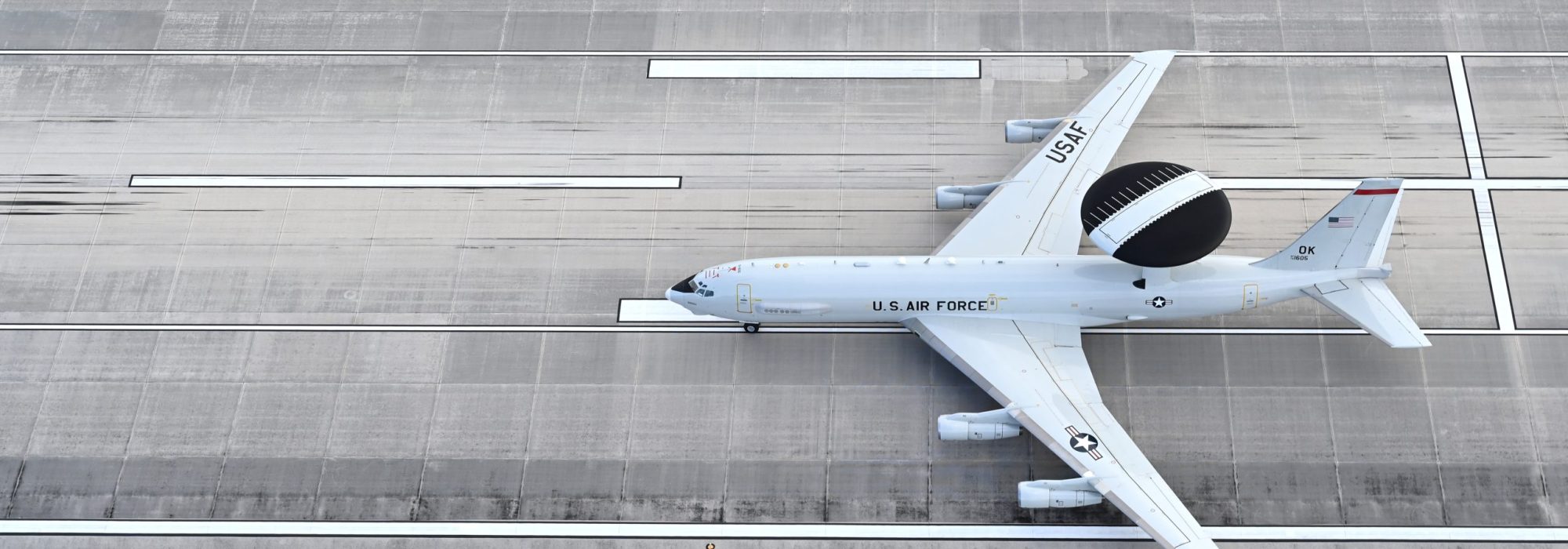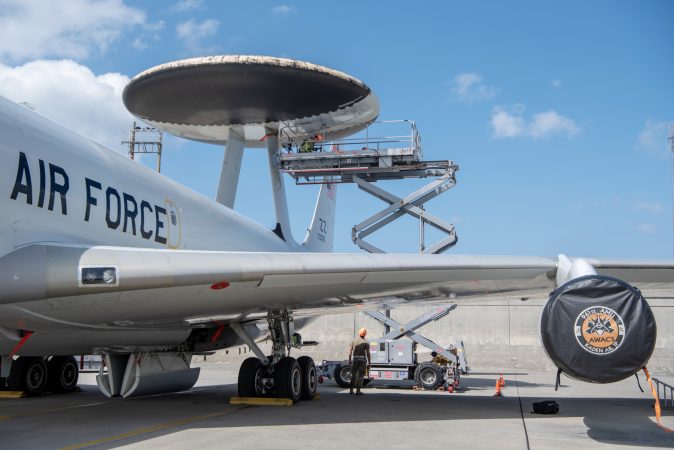As USAF awaits the E-7, Airmen keep the E-3 flying.
TINKER AIR FORCE BASE, Okla.
Observers have called the plane aging, old, even geriatric. A few have described its current state as being in “hospice care,” as they look forward to a replacement that is still years away.
Yet on the flight line and in the hangars here, the E-3 Sentry—known to most simply as AWACS, for Airborne Warning and Control System—still cuts an impressive figure, an airframe roughly the size of a KC-46 and sporting its distinctive radome. It’s that radome that led one general to proclaim the E-3 “the most significant single tactical improvement since the advent of radar.”
There are fewer than ever these days. To keep the fleet alive, the Air Force divested 15 of the aging jets and now maintains just 16 E-3s distributed around the globe, the airframes in the capable hands of a tight-knit collection of Airmen who maintain, fly, and operate the battle management aircraft every day.
It just really takes miracle workers … to keep these airplanes in the air. ”
—Gen. Mark Kelly, former head of Air Combat Command
“We’re still needed, the E-3—we’re still wanted,” an air battle manager standing in the back of an AWACS told Air & Space Forces Magazine this past summer. “The big eye in the sky, people always want that. So yeah, we’re not worried about it. Still busy.”
Keep ’em Flying
To be sure, the E-3 is old. Based on the “jet age” Boeing 707 first launched in the 1950s, today’s AWACS fleet entered service in the late 1970s and has been flying for nearly 50 years, much of it in the heat and dust of the Middle East.
The result is a fleet that breaks frequently and demands constant vigilance from maintainers, so much so that Gen. Mark Kelly, former head of Air Combat Command, said in 2022 that “it just really takes miracle workers … to keep these airplanes in the air.”
Miracles Take Time, Though
“Just to get one generated and get in the air, we work about 16 hours—just to prep the aircraft,” a maintainer said. “It’s not that the aircraft may be broken, that’s just the inspections … we do really diligent inspections. As the airframe gets older and older, the more we inspect and the harder we inspect. We start getting further into bigger components and making sure that we can safely fly the jet.”
Corrosion is a top concern. Every 18 months, teams perform isochronal inspections—essentially a “mini-depot,” the maintainer said.
Inside, the E-3 combines analog and digital components. Its varied sensors, miles of wire, and communications systems require a maintenance team of Airmen with 11 different Air Force Specialty Codes (AFSCs), three to four times the norm for other USAF airframes.
“When you have 11 AFSCs, and then you have multiple parts that integrate with each AFSC … at some point they have to mesh with each other. So, I may have availability of an avionics person to go troubleshoot this job, but I may not have a computer guy to go assist them,” he said. “That’s where it gets kind of janky when it gets to the maintenance side, is we have to integrate almost everybody.”
On top of that challenge, the small number of aircraft left in the fleet and the growing number of hours needed for repairs means that maintenance and operations must strike a delicate balance, one that requires daily communication said Col. Jason Zemler, commander of the 552nd Operations Group.
“When I was a captain … if you stepped on one jet and it wasn’t available, you went to the next jet, you went down the line, you would see a picture of a bunch of E-3s,” Zemler said. “Now, if you step to one and it’s not available, chances are high you’re having a long conversation with maintenance to really kind of understand the challenges with that jet and that airframe.”
Any change in the flying or maintenance schedule for one aircraft has a ripple effect on the others, said Col. James Combs, deputy commander of the 552nd Air Control Wing (ACW).
With such an old aircraft, replacements can be hard to find when components break; 707 production stopped more than three decades ago and parts suppliers have begun winding down production lines.
One logistics superintendent said sourcing spare parts requires her team to canvass contractors and scavenge the “Boneyard,” where retired aircraft can be cannibalized for hard-to-find parts.
“My job is just pushing the button saying, ‘Hey, where’s it at? We have aircraft that have got to fly,’” she said. “I’m the annoying mosquito.”
Not surprisingly, then, the E-3 is hardly a daily flyer. In 2024, the fleet’s mission capable rate—the rate at which aircraft are able to perform at least one of their assigned missions—was just 55.7 percent. That means that fewer than nine E-3s are available on any given day. That’s enough for peacetime, but would be a challenge in war.
“Our maintainers are able to maintain an aircraft availability rate commensurate with the level of training that we can maintain, in order to maintain the crews that we need, in order to respond to our global force management requirements,” he said.
Yet that’s not bad for a plane, Combs said, “that doesn’t have parts made for it anymore, that’s been used to the capacity that the E-3 has been used.”
Not Survivable
As valuable as the E-3 remains for orchestrating air assets and monitoring a battlespace, the E-3 is not fit for combat in a peer conflict.
Today’s AWACS is “not survivable in a future fight, so it doesn’t bring us the capability we need,” said then-Deputy Assistant Secretary for Budget Maj. Gen. James D. Peccia III, in 2022. The E-3, added then-Air Force Secretary Frank Kendall is “essentially not effective in the environments we’re most worried about.”
The Air Force has a rush plan in effect to acquire the E-7 Wedgetail as a replacement; based on the 737 airframe, with updated engines and a new multirole electronically scanned array (MESA) sensor, the Wedgetail will provide better, more consistent coverage and require fewer personnel.
The first E-7 is not scheduled to be delivered until 2027. In the meantime, USAF aircrew are learning to operate the aircraft with the Australian Air Force which already has the jets.
E-3 AWACS aircraft are stationed at Kadena Air Base, Japan, and Joint Base Elmendorf-Richardson, Alaska, as well as here, but the early cuts focused on Tinker and the 552nd Air Control Wing. Their aircraft started heading to the Boneyard at Davis-Monthan Air Force Base, Ariz., in March 2023, and over the next six months, 12 more followed. In 2024, two more left—15 aircraft gone in the span of a year and a half.
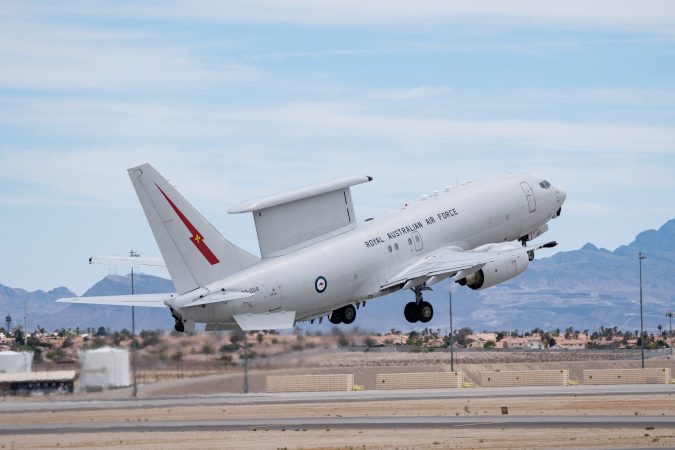
Lt. Col. Grant Georgulis, former commander of the 965th Airborne Air Control Squadron and now a fellow with AFA’s Mitchell Institute for Aerospace Studies, said the drastic reduction posed logistics and morale challenges.
“You got rid of the iron very quickly, but we still had all of the humans associated with that iron,” he recalled. “And so now you have a problem with being able to maintain currencies for a bunch of aircrew that no longer have the associated iron that allows them to maintain that training proficiency.”
Maintaining proficiency for pilots, air battle managers, and sensor operators even as the fleet shrunk was essential to retain knowledge and balance individual and USAF needs.
“We can’t really look at the divestment of the E-7 and the investment of the E-7 as two separate events,” Combs said.
“What we’re trying to do in this wing is to weave that together … to avoid as much of that brain drain as possible, while also balancing a need for the Airmen to continue to develop professionally.”
In the early going, Georgulis said, it was a struggle to get enough sorties for everyone while still giving maintainers the time they needed to keep the jets healthy. But as Airmen started rotating out to their next duty stations, the crunch to find everyone flying time eased.
“We used to operate with about 280 to 300 people per squadron,” Zemler said. “We’ve gone down to about 120 per squadron right now, so relatively smaller.”
That doesn’t mean all that talent has been jettisoned. Wing leadership is working on long-term plans to ensure manning is there when the E-7 arrives.
“We can look at PCS (permanent change of station) cycles, and we’re really trying to forecast, i.e., I may want to actually let somebody PCS now, so that they can go do a three-year time on station somewhere else, and then I can bring them back when we’re onboarding to E-7,” Combs said.
Still, as the wing shed personnel and aircraft, leaders worried about talent retention and how Airmen would react.
“To be frank, [2023] was a little tough,” Zemler said. “When you watch airframes fly away to the Boneyard, it’s a pretty insightful moment when you actually visibly see less airframes on the flight line. So [2023], I would say it was pretty eye-opening. But I think we’ve kind of come far from that now to really see, ‘This is where we were at. This is where we put our focus.’”
Airmen left behind inevitably feel they are being asked to do more with less.
“We’re trying to really get in front of recognizing our Airmen for all the good stuff they do, pointing out that when times come up where it’s very busy, it’s easy to maybe look past something,” he said. “But even though you’re busy and you’re tired, and you still do the right thing, we get them the recognition, and we make sure that that’s public recognition.”
Still Going
The Wedgetail successor is every bit as a visually striking as the E-3. The Royal Australian Air Force (RAAF), which operates the E-7, regularly hosts American Airmen in an exchange program to teach them about the new platform. The RAAF has brought the Wedgetail to exercises such as Red Flag, and senior USAF leaders have flown on it.
But Georgulis had a simple way to ground anyone in his unit getting dreamy-eyed thinking about the future.
“Hey, this jet [the E-3] is going to be flying for next 10 years,” he said. That’s not a long time for some old-timers, but for young Airmen it’s half a life. “‘What were y’all doing 10 years ago? You were in high school,’” Georgulis said he tells young Airmen who might get dreamy eyed about the coming E-7. “So think about that like you have another 10 years before we have to really start thinking about it.”
For now, the Air Force still rarely conducts a large-scale exercise without an E-3 to command and control fighters, deconflict airspace, and more. So far in 2025, AWACS have popped up everywhere from Greenland to Guam.
And while the Air Force is investing in new ground-based command and control equipment and hopes to move some of its targeting mission to satellites, leaders say airborne C-2 remains critical for its range and flexibility.
That means training and operations are still just as urgent—and intense—as ever for the dozen or so crew members on each E-3 flight.
“As soon as the computer is ready to go and it’s turned on, we’re setting up our scope, making it look how it needs to,” an air battle manager said. “The sensor operators are checking out their systems, making sure they’re optimized, making sure it’s ready to go. Because as soon as the fighters say, ‘Fight’s on,’ that means that it’s go time. We’re in the mission. … It’s intense. There are things always happening. You’re checking in, making sure that people are being safe, that fighters aren’t running into each other or going out of the airspace. And when the fight is happening, you’re providing the new information they need, keeping things up to date. It’s never like sit back and just observe.”
On the ground, a new flight simulator helps operators hone their skills without burning expensive flight hours. The new sim is a “big pod up on hydraulic stilts,” providing full-motion realism so pilots can drill on emergency procedures and aerial refueling.
Actual flight hours are still critical, though, and the wing’s maintenance and operations groups work together, Combs said, to build “some very creative scheduling processes.”
“When I came in, there were a bunch of old heads that didn’t want to change,” the maintainer said. “Then we became more innovative with how … we can make a troubleshooting process easier, faster, stuff like that. If we don’t give these guys the freedom to think on their own and come up with these ideas, we will never get these aircraft off the ground.”
Value Added
Given the E-3’s age and shrinking fleet size, it’s hardly surprising that wing leaders say the Air Force has become more judicious in how it deploys and uses the AWACS. With years still to go before E-7, they want to preserve what life the remaining aircraft have without overtaxing the iron or the humans who work on it.
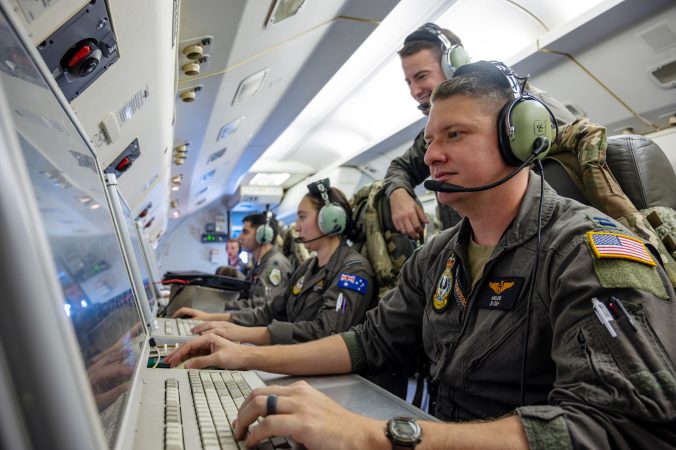
Yet within the proud AWACS community, there’s a sense that the aircraft has plenty of useful life left.
“We keep evolving the equipment,” said one airborne data system technician. “We keep pressing forward and adding what we need to add to our jet to make sure that we’re capable at any given moment.”
Old-school technology that once recorded data on tapes are now gone. “The first version that I flew in was not a Windows based system,” Zemler recalled, harkening back to the early 2000s. “You used to have to type codes and lines in there in order to get one of the three colors you were going to have on the display.”
Now the interface is like that of a laptop or home computer, said the technician: “It runs just as fast and just as clean, and it’s just as user-friendly.”
The AWACS cockpit has likewise been overhauled, upgraded with new digital multifunction displays, featuring “a moving map display for us on one side, and a lot more control and situational awareness on what we’re doing, where we’re going,” explained an AWACS pilot said. “Everything being digital now goes through the analog converters to a digital display and shows us just a lot more of what’s going on. It’s more modern compared to the old steam gauges.”
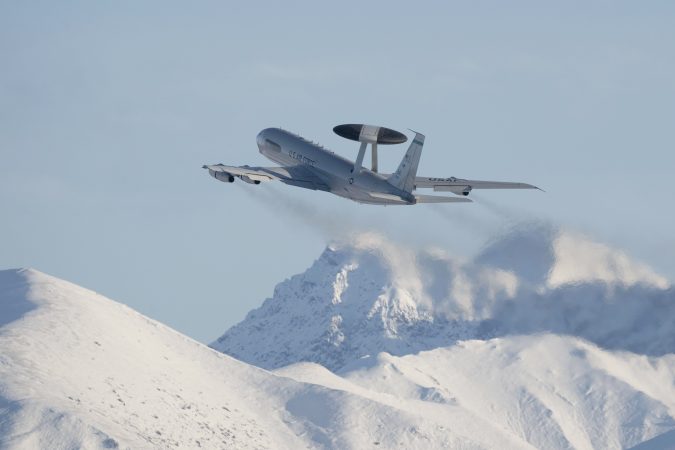
The connections between analog and digital systems can be difficult to keep up and the hydraulic controls require a level of precision on the part of pilots that fly-by-wire systems don’t need, but Airmen describe an affection for the Sentry that runs deep, formed over hours of studying, chatting, and playing UNO while en route to mission locations deep into the night. Said one engineer of the workspace: “It’s the best office you can have, tons of great views from 30,000 feet.”
“I love AWACS,” the maintainer said. “This AWACS community has been my home for 15 years, so I can’t speak for other airframes, but I don’t think I would ever want to go to another one, with just how family and tight-knit the 552nd ACW is completely.”
And it’s getting even more tight-knit as the community shrinks.
“I truly believe, if we were asked to go to combat tomorrow, the Air Force or the joint staff would still ask for [AWACs],” Zemler said. “And that’s not chest pounding. … We really put in a lot of effort with our maintainers and our ops individuals to stay on the leading edge as much as possible, to be there at the moment of need.”
